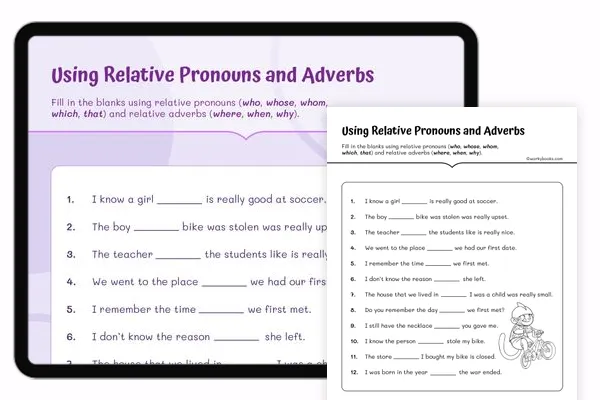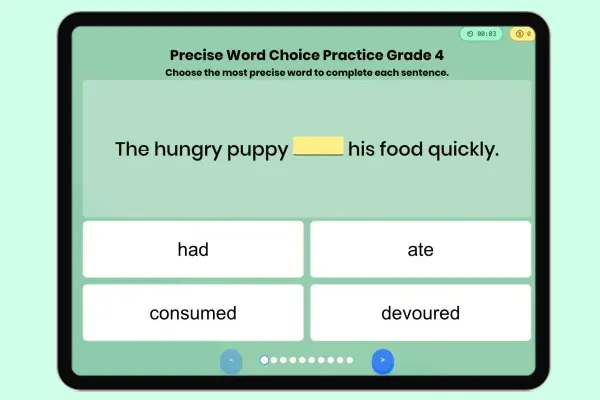Relative Adverbs Practice Worksheet
- 4
- 5
- L.4.1.A
- L.4.1
This learning resource is available in interactive and printable formats. The interactive worksheet can be played online and assigned to students. The Printable PDF version can be downloaded and printed for completion by hand.
About the "Relative Adverbs Practice" Worksheet
Relative Adverbs Practice is an engaging language arts worksheet designed to enhance students' understanding and application of relative adverbs in sentence construction. This interactive and printable worksheet presents a series of ten incomplete sentences, challenging students to fill in the blanks with the appropriate relative adverbs: where, when, or why. The exercise covers a range of contexts, from personal experiences to general situations, providing a comprehensive practice in using these important grammatical elements.
The worksheet offers a diverse set of sentences that require students to think critically about the relationship between clauses and select the most fitting relative adverb. By working through these examples, learners will develop a stronger grasp of how relative adverbs function to connect ideas and provide additional information within sentences. This practice not only reinforces grammar skills but also encourages students to recognize the nuances of language use in expressing time, place, and reason. As students complete the worksheet, they will gain confidence in their ability to construct more complex and descriptive sentences, enhancing their overall writing proficiency.
What will your child learn through this worksheet?
- Proper usage of relative adverbs (where, when, why) in sentences
- Understanding the function of relative adverbs in connecting clauses
- Recognizing contexts that require specific relative adverbs
- Improving sentence structure and complexity in writing
Learning Outcomes
- Students will correctly identify and use appropriate relative adverbs in at least 8 out of 10 sentences
- Learners will explain the function of each relative adverb (where, when, why) with 90% accuracy
- Children will create five original sentences using relative adverbs correctly
- Students will demonstrate improved writing skills by incorporating relative adverbs in a short paragraph
Cognitive
- Analyze sentences to determine the appropriate relative adverb
- Apply knowledge of relative adverbs to construct grammatically correct sentences
Psychomotor
- Develop fine motor skills through writing practice
- Improve handwriting legibility while filling in the blanks
Affective
- Foster confidence in using more complex grammatical structures
- Cultivate an appreciation for precise and descriptive language use
Interpersonal/Social
- Engage in peer discussions about sentence structure and relative adverb usage
- Collaborate on creating and solving relative adverb puzzles with classmates
Tags
relative adverbs, grammar practice, sentence structure, language arts, writing skills, where, when, why, clause connection, grammatical elements
Common Core Standards Covered
Perfect For:
- • Classroom assignments
- • Auto-graded assessments
- • Printable handouts
- • Home learning support
- • Homework help
- • Skill reinforcement
- • Curriculum planning
- • Self-paced learning
- • Progress tracking










